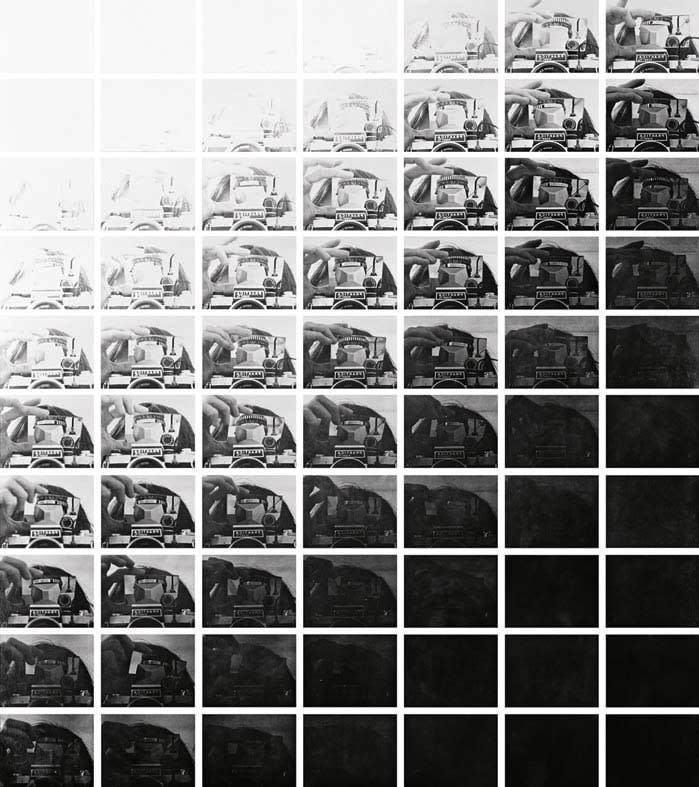John HILLIARD British, b. 1945
Study for Camera Recording Its Own Condition (7 Apertures, 10 Speeds, 2 Mirrors), 1971
Black and white photograph mounted on white board
61 x 55.5 cm
Edition of 3 (printed 2013)
'Camera Recording its Own Condition’ is an important example of Hilliard's early serial photographic works. These were chiefly made between 1970–3, and concentrate on the camera itself as a mechanical...
'Camera Recording its Own Condition’ is an important example of Hilliard's early serial photographic works. These were chiefly made between 1970–3, and concentrate on the camera itself as a mechanical device, usually subjecting a repeated image to a predetermined and technically dictated set of conditions, demonstrating in serial form the controls operating in ‘basic’ photography, before any aesthetic intervention has taken place. In these early works the imagery in each photograph will often directly reflect and report on the technical or chemical conditions which caused the final photographs to appear as they do, (e.g. light readings, shutter speeds, printing).
The central image in this work, visible in varying degrees across seventy black and white photographs, arrayed in ten rows of seven across, is the artist's camera, an East German made Praktica. The camera, which is operated by Hilliard, is reflected in two mirrors, the larger of which presents a reversed image of the subject. Hilliard also holds up a smaller mirror which reflects and makes legible the camera's setting and controls. The variables governing the making of the work are indicated by the second part of its title, ‘7 apertures, 10 speeds, 2 mirrors’ - the camera has become both the subject and object of the work, in that the seventy photographs show the images resulting from all combinations of aperture size and shutter speed in that camera. Across a diagonal axis, where the exposures are ‘correct’, it is possible to read the camera settings which produced each image. Where the photographs have been sequentially over or under-exposed, the next reading can usually be logically inferred.
The central image in this work, visible in varying degrees across seventy black and white photographs, arrayed in ten rows of seven across, is the artist's camera, an East German made Praktica. The camera, which is operated by Hilliard, is reflected in two mirrors, the larger of which presents a reversed image of the subject. Hilliard also holds up a smaller mirror which reflects and makes legible the camera's setting and controls. The variables governing the making of the work are indicated by the second part of its title, ‘7 apertures, 10 speeds, 2 mirrors’ - the camera has become both the subject and object of the work, in that the seventy photographs show the images resulting from all combinations of aperture size and shutter speed in that camera. Across a diagonal axis, where the exposures are ‘correct’, it is possible to read the camera settings which produced each image. Where the photographs have been sequentially over or under-exposed, the next reading can usually be logically inferred.
Exhibitions
Glitch: The Art of Interference, Die Pinakotheken, Munich, 1 December 2023 - 17 March 2024Occasional Geometries, curated by Rana Begum, Longside Gallery, Yorkshire Sculpture Park, 2017
Join our mailing list
* denotes required fields
We will process the personal data you have supplied to communicate with you in accordance with our Privacy Policy. You can unsubscribe or change your preferences at any time by clicking the link in our emails.
